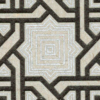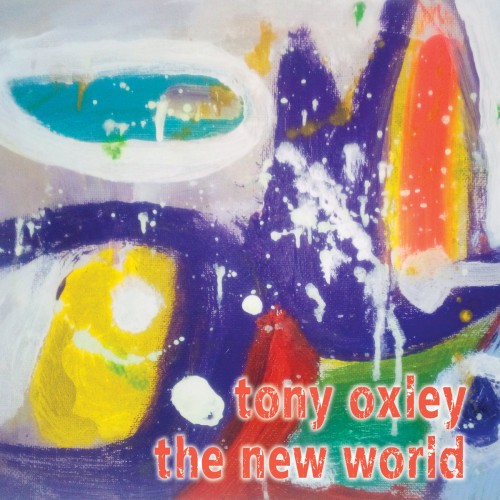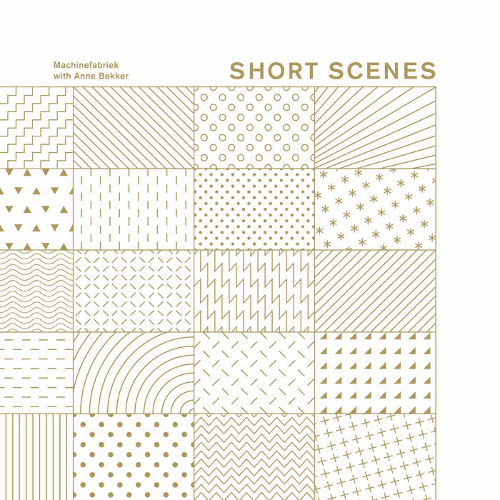– Iranair Inflight Magazine
– Red Madrassa
– Jebel Tariq
Label: Muslimim Format: CD
– Arabbox
Label: Soleilmoon Format: CD
–In Search Of Ahmad Shah Masood
Label: Nexsound Format: CD
Recent months have seen the continuing flow of Muslimgauze releases slow down considerably – given that it is now five years since Bryn Jones‘ untimely death, this is hardly surprising, but that it has taken this long is in itself a testament to the legacy of finished material he left behind. This round-up of new and reemergent material covers only some of the diverse CDs which have appeared – a second instalment is likely to follow shortly.
 With track names taken from the Iran Air Inflight Magazine of the album title and referring in turn to the passenger jet of that airline shot down, apparently by mistake, by the US Navy over the Persian Gulf in the mid-Eighties, Bryn Jones’ trademark percussion sound is found once again to have mutated and expanded. Here relying on a more mechanized sound among the hiss of radio static, twangs and drones of Middle- Easten music and the occasional elided vocal snippet, Muslimgauze rattles out the beats with a shimmering crunch.
With track names taken from the Iran Air Inflight Magazine of the album title and referring in turn to the passenger jet of that airline shot down, apparently by mistake, by the US Navy over the Persian Gulf in the mid-Eighties, Bryn Jones’ trademark percussion sound is found once again to have mutated and expanded. Here relying on a more mechanized sound among the hiss of radio static, twangs and drones of Middle- Easten music and the occasional elided vocal snippet, Muslimgauze rattles out the beats with a shimmering crunch.
The linear rhythmic style extending through the seven tracks, there is the feeling of cut-up drum machine percussion at work on some pieces, and though Jones spoke of his eschewal of such intruments in interviews in favour of tape-loops, perhaps this was part of a (or rather one of many) new sound he was developing before his death. The skipped beats and ghostly samples break up what could otherwise drift into monotony, startling the listener back into attention should it wander lost in the hypnotic drift of zithery twangs found on “Unfinished Mosque Of The Hotel Menzah Zalagh” or the equally sensuous drone of everytake life in the souk which whirls around the steady Dub pace set on “No Maps Of Dar-es-Salaam Show This”.
Regardless of methodology, the lugubrious density of rhythm and sound on display here does what Muslimgauze tends to do on a scale to match the heaviest of dub plates, most brutally noisy Industrial catharsis and soaring of orchstral works, and fills space with sound – and as importantly, with spaces between the beats and drones.
 Red Madrassa is listed as being re-mixs (sic) dating from April 1998, and brings matters back firmly into the realms of distended volumes of sound and churning rhythms. The album opens with nearly twenty minutes of “Rhodesia”, which turns around some lengthy percussion loops, precariously wobbly bass and a repeated sample of a disinterested Westerner enunciating various permutations of “like children defecating in a shrine” as if on a dated language instruction tape, the whole sensously immersive piece wrapped in ghostly radio drones and calls and the never-ending mutter of the Middle Eastern airwaves. Perhaps due to and in spite of the duration of this track, a feeling of dense claustrophobia is soon engendered, with torn fragments of liquified tape noise ripping suble tears from the soundscape like peeling wallpaper, a process enhanced by the gradual disruption of the rhythmic structure by closely-packed delay effects.
Red Madrassa is listed as being re-mixs (sic) dating from April 1998, and brings matters back firmly into the realms of distended volumes of sound and churning rhythms. The album opens with nearly twenty minutes of “Rhodesia”, which turns around some lengthy percussion loops, precariously wobbly bass and a repeated sample of a disinterested Westerner enunciating various permutations of “like children defecating in a shrine” as if on a dated language instruction tape, the whole sensously immersive piece wrapped in ghostly radio drones and calls and the never-ending mutter of the Middle Eastern airwaves. Perhaps due to and in spite of the duration of this track, a feeling of dense claustrophobia is soon engendered, with torn fragments of liquified tape noise ripping suble tears from the soundscape like peeling wallpaper, a process enhanced by the gradual disruption of the rhythmic structure by closely-packed delay effects.
The first “Rya Ba Mutant” skips in on a heavyweight rhythm, undercut into discordance by layered echoes, cutting jarringly into the second version of “Rhodesia”, distinguished only by its far shorter length of a shade over five minutes, which blasts the tempo up into overload, as grinding mechanical sounds, possibly sourced from railway sidings, scrape across the urgently bashed out beat. The relative shortness of these two tracks is to be appreciated, as much longer would provoke a skip forward in all but the hardest of Gabba freaks out there; even so, the thorough earbashing dealt out in a welter of yet more echo-smacked rhythms perks matters up no end. Two more variations on “Rya Ba Mutant” follow, sprinkled liberally with tweaked-over birdsong, dirtified Rai-Ragga confusion and querulous bass inquiries.
The last take on “Rhodesia” spans tracks 6 to 8 of Red Madrassa, and makes for half an hours worth of densely-scrambled electronic Dancehall spasming (Tk.6, 9:57), the morphing rhythms squeaking and blipping their jack-plug pulling glitches into stuttering dissolution for the metallic-tasting reprise of Tk7. Three minutes of almost funky electrified keyboard grooving and a hyper-Dub reprise in a garden of distorted avian delights heralds the outgoing marathon of 17 minutes spent in recapitulation of Track 1. Here the bassy low drum repeater strains hard at the speakers and the hiss levels drizzle into an all-enveloping miasma of heavily processed ripples and timestretching as the Filmi voices utter their clipped story fragments and emotional outbursts into the echoing tapeloop wind of spluttering delay glitches left to flow out at their own pace.
Overall, despite a generally unfinalized feel to the repeated structures and rewokings of basic themes at what might be regarded as undue length, Red Madrassa is a prime example of Bryn Jones’ terrier-like worrying away at a musical idea until it is shaken into submission – much like his overwhelmed listeners. Something of an endurance test, the results can be hugely satisfying in what can only be described as a somewhat Nietszchean way.
 Jebel Tariq is a Staalplaat/Muslimim re-release of an album previously available only as a download from the Muslimgauze website for a limited time in 2000, complete with images of the sleeve. Now in an edition of 700 in a new Digipak sleeve, the album once again features a grim Mujihad seated on the cover, now with equally steely-eyed daughter at his side surrounded by mint tea and Kalashnikov.
Jebel Tariq is a Staalplaat/Muslimim re-release of an album previously available only as a download from the Muslimgauze website for a limited time in 2000, complete with images of the sleeve. Now in an edition of 700 in a new Digipak sleeve, the album once again features a grim Mujihad seated on the cover, now with equally steely-eyed daughter at his side surrounded by mint tea and Kalashnikov.
The album flows in one long ripple of complex percussion and Dub bass, interlocking groves dropping in and out of the reedy drone of ney pipes and the bustling sounds of the souk and radio muezzin. Once again, the historical and political references aboud: Jebel Tariq is the Arab name for Gibraltar, and “Fall Of Granada” refers back to the expulsion from Spain of the Moors. Musically, this is one of Jones’ more relaxed efforts, shimmering with echo effects and the jangle of horse tackle and the click of their hooves merging into tapeloop drones on this last track to evocative effect.
 Flutes, broadcast fragments and conversation pepper the brighly-struck percussion and weighty bass of the related tracks “Maghribi Hamza” and “Maghribimaz”, conjuring the bustle of street life in North Africa with an effortlessly beguiling sense of place. “Orange Camel Sherbet” in particular glides through a dreamlike psychogeographic landscape, the percussive strike building and dropping into a satisfyingly descriptive whole, while “Agadir” swings on plucked string loops and a rubbery bass while the drums pound in a furious staccato breakdown. The vibrant energy of the Muslimgauze sound is nowhere more evident than on the title track, with hyperkinetic loops skipping relentlessly as an Arabic song is plucked from the airwaves and rendered into the tirelessly groovy mix. Artificial and imagined as the soundscapes may be, the feel for a much-maligned culture is evident throughout Jebel Tariq and this album stands as a particular highlight of the Muslimgauze catalogue when in its expansive, hallucinogenic mode.
Flutes, broadcast fragments and conversation pepper the brighly-struck percussion and weighty bass of the related tracks “Maghribi Hamza” and “Maghribimaz”, conjuring the bustle of street life in North Africa with an effortlessly beguiling sense of place. “Orange Camel Sherbet” in particular glides through a dreamlike psychogeographic landscape, the percussive strike building and dropping into a satisfyingly descriptive whole, while “Agadir” swings on plucked string loops and a rubbery bass while the drums pound in a furious staccato breakdown. The vibrant energy of the Muslimgauze sound is nowhere more evident than on the title track, with hyperkinetic loops skipping relentlessly as an Arabic song is plucked from the airwaves and rendered into the tirelessly groovy mix. Artificial and imagined as the soundscapes may be, the feel for a much-maligned culture is evident throughout Jebel Tariq and this album stands as a particular highlight of the Muslimgauze catalogue when in its expansive, hallucinogenic mode.
 Arabbox comes from an earlier Muslimgauze era, having been recorded live in July 1993 at the turkish baths in Manchester where Jones lived. This second edition release from Soleilmoon differs only from the first limited version in packaging and consequent price reduction.
Arabbox comes from an earlier Muslimgauze era, having been recorded live in July 1993 at the turkish baths in Manchester where Jones lived. This second edition release from Soleilmoon differs only from the first limited version in packaging and consequent price reduction.
The album drifts up from the watery depths of “Ganges Swimmer”, rolling on waves of steady rhythm and filigree sitar drones, surrounded by the hum and natural echoes of the space in which it was recorded. Relaxing back into the fullsome flow of the album soon engenders an ambient connection with notions of recorded setting and Jones’ engagement with a wide-ranging culture at once distant and close to his home in the once industrial North-West of England. As creations of synthetic worlds go, the entire Muslimgauze catalogue is one which exists in a space of constructed travelogues, and his imaginary fusion of exotic imagery and sound into a coherent musical universe is one which remains stunning not only for its depth and breadth but its continuing ability to emerge in new forms some years after his death.
That Arabbox occasionally drifts into sleepy passages of hallucinatory FX and treatments is perhaps entirely suited to the pampering, enveloping pace of a visit to the turkish baths; the languid dub tendencies and reverberating tapped strings of “Basra” or the chatter of a child’s voice which introduces the patient percussion of the title track is joined by Arabic conversation (some of which is also Francophone or in English) at barely audible levels. This is a familiar Muslimgauze strategy to enhance the mood and conjour a vision of a psychedelic Middle East, to paraphrase Brian Eno and David Byrne‘s inspiration for their faux-African ambient adventure My Life In The Bush Of Ghosts. Jones has acheived a similar level of immersive musical globe-trotting here and elsewhere, but to a far more involving degree of dedication and continuing single-mindedness.
Filled with dreamlike concoctions of thunderstorms and the ever-present variations on drones and tones and the pervasive swells of keyboard ambience brushing close to overload grounded on the ever-guiding rhythms, this album can frequently lull the listener into other worlds where the gentle pace is cut with hints of harsher moods, a tendency reflected in the loaded wordplay of titles like “Saddambush” or “Veil Of Tear Gas”. Even at his most apparently mellow, Jones doesn’t let up the political content – or perhaps more accurately, context – of his work.
 In Search Of Ahmad Shah Masood is a rerelease of an album which previously appeared on Staalplaat, here again as a limited edition, this time of 500. There have beens some stunning covers on Muslimgauze releases in the past, but Ukrainian label Nexsound have surpassed them all here: the heavyweight card gatefold packaging is superb, traced in embossed bold black and silver lines in a beautiful Arabic-modernist style. The ink itself if fragrant with a sweet, heady industrial printing smell, adding further to the sensual delight the object itself engenders.
In Search Of Ahmad Shah Masood is a rerelease of an album which previously appeared on Staalplaat, here again as a limited edition, this time of 500. There have beens some stunning covers on Muslimgauze releases in the past, but Ukrainian label Nexsound have surpassed them all here: the heavyweight card gatefold packaging is superb, traced in embossed bold black and silver lines in a beautiful Arabic-modernist style. The ink itself if fragrant with a sweet, heady industrial printing smell, adding further to the sensual delight the object itself engenders.
So much for the fetishising of presentation: the recording comes in four bass-laden parts, the underlying rolling rhythm swaying to those sharp percussive beats while Jones switches the hisses and rattles in and out of the mix. This anti-melody of unsettling clips and drop outs becomes familiar in times, if never losing the ability to disturb the otherwise regular loops. If it wasn’t for the unspooling grooves, interrupted as they are, it would be difficult to tell if the CD player was skipping or not – or if the master tape was caught in the spindles. This capacity for foregrounding the process of production is a hallmark of Muslimgauze releases around this time (the later Nineties – Ahmad Shah Masood dates from 1997) and Part One trembles under the pressure, halting before complete disintegration sets in.
Part Two ups the level of distension and distortion considerably, with only the bright percussive hits and occasional shards of processed/looped reeds keeping the track from entering the realms of sub-bass noise more typical of minimalist Drill and Bass extremism. As such, at over eight minutes of increasing intensity and layered repetition, it does almost manage to outstay its welcome, but a bit like (figuratively) banging one’s head against a brick wall, there is a certain satisfaction in the release that comes with termination. The frying pan sounds expand further into Part Three, as does a certain level of digitally-eviscerated, even hip-swaying funkiness; sounding like it was recorded inside the bass bins of a very small club with the levels turned up beyond tolerable into into the realms of punctured eardrums and loosened bowels. For Part four, the dynamics are enhanced by dubs which drop the fearsome noise levels down and bring them back as the clarity of a new basic percussion loop ebbs and flows into yet further areas of trebly distortion and groovable noise which recede in density if not dissonance. The conclusion is little short of genius, as squittering mid-range interference patterns buzz around the speeding-up rhythms like a helicopter full of bees falling into a seemingly endless semi-controlled nosedive. In Search Of Ahmad Shah Masood is a supremely physical listening experience, particularly in the latter half of the disc, and a pinnacle of the Muslimgauze sound at its most beautifully dirty.
In these times of an alleged “clash of civilizations” and neo-colonial wars, even to release this sort of material in the United States (and, increasingly, Europe) is probably tantamount to inviting the suspicion of the DHS and internal security agencies, so Soleilmoon, Staalplaat (who have had pressing plants refuse to produce CDs in the past) and Nexsound are to be applauded for their continuing commitment to keeping Muslimgauze releases flowing.
-Richard Fontenoy-
Links:
Official Muslimgauze website


